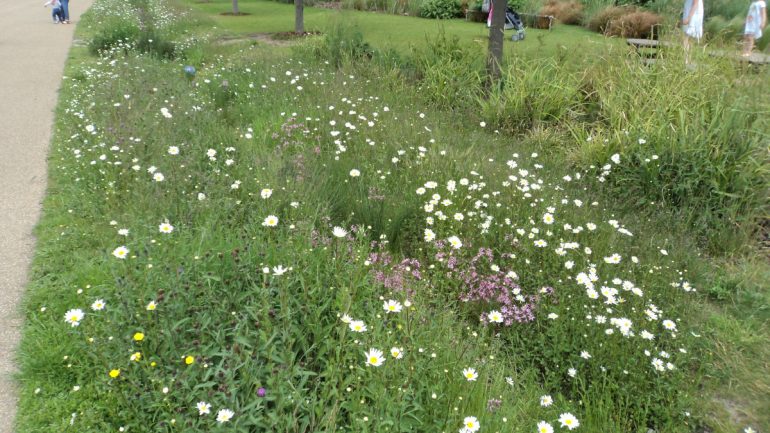We are facing a climate emergency but that doesn’t mean that we need to reduce and restrict our approach to design and management of our housing greenspaces. What we need is to see urban landscapes as a rich resource that can provide multiple environmental and social benefits. Landscapes that are designed and managed from the onset in this way, also inevitably develop a completely distinctive and unique sense of place, as well as providing significant biodiversity gains. The good news now, is that there are many tried and tested examples to learn and get inspiration from.
Sustainable drainage systems offer a range of environmental and economic benefits. From an environmental standpoint, they help to manage the impacts of urbanisation and reduce the risk of flooding by mimicking natural drainage systems. SuDS can also improve water quality by removing pollutants and sediment from rainwater runoff before it reaches watercourses. They can also enhance biodiversity by providing habitats for wildlife and green spaces for people to enjoy.
Here at Pictorial Meadows™ home base in Sheffield, a lot of innovative approaches have emerged specifically in response to both new and existing social and affordable housing. One of the most mature schemes is the award-winning Green Flag Manor Fields Park. A district park created out of a matrix of post war council housing demolition, waste land and abandoned allotments, in what was then branded as ‘the Worst Estate in Britain’. Three distinctively different Sustainable Urban Drainage Systems ( SuDS) form the large proportion of this 22 hectare site and all serve varied adjoining housing estates. A fourth major scheme is just about to be retro-fitted, to serve new housing now under construction. The savings made through designing on-site SuDS, rather than off site piped drainage, has been used to create a long-term endowment fund, that has helped provide year on year park management.

Not only has this park been a test ground for urban SuDS schemes, but a demonstration site for The Green Estate’s Pictorial Meadows™, incorporating a wide range of innovative meadow plantings. These help to bring explosive masses of flower and colour across the landscape with very minimal associated maintenance costs. Over time, this very urban greenspace has transformed the neighbourhood and developed a really rich variety of habitats, which are also amazingly robust in terms of public use. The complexity and ecology of the park has also been a major factor in attracting and retaining a solid core of local volunteers, who take enormous pride in helping to maintain this rich landscape for both people and wildlife. In turn this ‘animation’ has made this once ‘no go’ area a safe and inviting place, not just now serving local residents, but drawing visitor from across the city.
Learning from this scheme was rolled out across many other estates in Sheffield. One of the more recent, is the 4 hectare Woodthorpe Ravine Park , until just a couple of years ago, another unloved and abused stretch of greenspace separating 1950’s council housing with a development site ear marked for both new mixed social and private housing. Working proactively with the developers, the whole space was reformed whilst the new housing was being built to manage all the surface water run off from the new estate. Water has, and is, a dominant theme in the park and one that is still evolving with paths, meadows, informal play areas and mini woodlands integrated throughout.
In Sheffield City Centre these new ways of combining flower rich ‘designed meadows’ with SuDS have been further developed with the University of Sheffield into the Grey to Green scheme. Another award-winning design from the Sheffield School, that has transformed the once desolate inner ring road into a stunning low maintenance sustainable transport route. At the same time, it deals effectively with the previous serious road flooding issues. This civic, very sustainable, ‘rain garden’ style design is especially suitable for social housing where shared use roads, verges and car parking areas form the major element of the outdoor spaces.
The effects of global warming are serious and will be felt most strongly in our urban housing areas, many of which have not been designed for the changing climate. Proactively mitigating some of these impacts through more sustainable design is needed now. Everyone also deserves beauty and a beautiful environment has a major impact on our health and wellbeing. We have learnt over the past 20 years that by working creatively with both nature and the environment that we can transform our urban landscapes in ways which can deliver more sustainable ‘Beauty on a Budget’, we just need to be a little more ambitious in how we build these ideas into new and existing housing and urban developments.
To discuss your project with us, call 0114 267 7635 or email us here.






